Photo: Daniel Studio
Who: Philadelphia Union vs. Toronto FC
What: 2016 regular season game
Where: Talen Energy Stadium
When: Saturday, August 20 at 7 pm
Watch: TCN, MLS Live, Direct Kick
Whistle: Mark Geiger; Claudiu Badea and Kevin Klinger; Rubiel Vazquez
If 2016 Toronto FC had an accurate slogan, it would be: “Come for Giovinco, stay in case Jozy Altidore is healthy enough to come off the bench… and hey, why not check out our defense while you’re here?”
TFC is best team in the Eastern Conference, full stop. And not because they have Giovinco, though he’s incredible. Not because they have Michael Bradley, though he certainly helps a lot. TFC is the team best built to compete with the Western Conference powers because they have a strong, flexible, and dynamic defense. Those adjectives may be too flowery, so let’s be straightforward: Toronto’s defense has been really, really, really good for a while now.
The defense is for real
The reds have the best defensive record in the East, and the only team even close to them is DC United (a club that plays so much defense they often forget about offense altogether). TFC has given up more than a single goal in a game one time since June, a 2-1 road loss to San Jose that was just about as weird as a MLS match can be (two red cards for SJ, both rescinded later, and a very weird winner for the Quakes).
Keep in mind that TFC is doing this with a young goalie who hadn’t made a MLS start before July, and they have done it with a largely unchanged roster from 2015. Instead of investing money in a big central defender (like NJRB), Toronto, like Colorado out west, has turned into a stellar defensive unit through shrewd, cost-effective roster building.
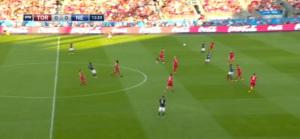
TFC high defensive line to squeeze out space in midfield.
Free agent Drew Moor now sits in the center of a mobile, active three-man back line. Steven Beitashour arrived in a trade with Vancouver and now competes for wingback minutes with Justin Morrow, Mark Bloom, and Ashtone Morgan. Recovery project Josh Williams has been stellar as an outside center back after health and consistency issues derailed his stints in Columbus and NYC. Tsubasa Endoh seemed like a reach in the SuperDraft but has been utilized in forward roles for his workrate and commitment to simple play.
After years of looking for a coach or player who could magically turn the perennial bottom-feeders into contenders, Toronto finally realized that MLS’ unique roster rules make it extremely difficult to shoot straight to the top (unless you’re in LA or New York City). As a result, Head coach Greg Vanney has been given time to fail, implement a system, and drill it into the heads of a young, eager team. The result is a coordinated, energetic, and unconventional defense that the rest of MLS has yet to figure out.
How they do it – Three in the back
The main goals driving TFC’s defensive system are not revolutionary, but the way Vanney (who I have, mea culpa, egregiously underrated in the past) arrives at those goals is innovative, at least for MLS. Toronto wants to keep teams out of the middle in the final third. They play with three central defenders who spread out with the ball but collapse to become narrow defensively. The midfield also collapses very central, often with three players in the 10-15 yards most central on the pitch.
Additionally, the three backs play a very high line, looking to compress space in midfield to protect against their biggest weakness: accurate diagonals into the corners. To the extent that TFC can keep the midfield space at a minimum, they can restrict the time opposing players have to look up and pick out longer passes. The Union have, of course, run into this sort of thing before against New Jersey. Facing Jesse Marsch’s side, Jim Curtin said that his team would rely at times on blind switches of field. The thought was that NJRB was so committed to ball-side pressure that the worst outcome of a blind switch of play was that the ball rolled to nobody; that’s far better than losing possession in your own half to a team with bodies around the ball and counterattacking on their mind.
In order to restrict space, Toronto complements that high back line with Michael Bradley’s central mobility. Defensively, Bradley remains close to the defense and often looks like a driving school instructor for his younger midfield teammates. As wingbacks and narrow midfielders press the ball in wide areas, Bradley stays 5-8 yards away shadowing the passing lane into the channel. This is the most impressive innovation Vanney has introduced defensively: TFC has the ability to create numerical advantages because Bradley funnels play to the wings while protecting the channel. Thus, opposing teams are deprived of their most dangerous outlet pass from wide areas, Bradley doesn’t abandon the center, and there are often more defenders in close proximity to the ball than there are attackers.
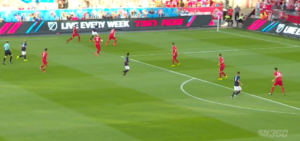
TFC overloads the side of the pitch with the ball, allowing Michael Bradley to shadow lanes into the center.
In a recent match against New England (see left image), you can see what happens when teams get into areas where they typically have 1v1s against opposing fullbacks. Instead, Toronto presses the ball with a wingback, pulls a midfielder in as shadow, and allows Bradley to sit a few yards off, essentially protecting against a pass into the channel.
Normally (and Giovinco will absolutely pose this problem for the Union on Saturday), a ball out wide in the final third forces the fullback wide with a holding midfielder in support and a center back near the top of the box. Intelligent attackers like Giovinco or David Villa like to slide in between the holding mid and central defender, forcing both players to quickly decide who steps to the ball and who remains. Either way, once the ball is in that channel, a host of options appear, from a run in behind off the wing to a late runner through the center, to a quick ball outside and a cross into the box that arrives before the central defender can recover. I mean, there’s a very good reason that very good strikers pop up in that hole. It’s the same reason to get pieces on a chess board in a position that simultaneously threatens two of your opponent’s pieces. In chess, the opponent must choose which piece to sacrifice. On the soccer pitch, defenders must decide which of them will sacrifice positioning, and they must do it instantaneously and in a coordinated fashion. Easy? Nah.
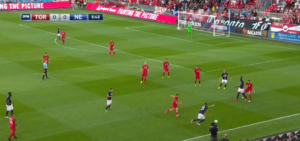
TFC again creates a numerical advantage in wide areas without sacrificing the center.
Below, you can see a TFC defensive overload in action. Look at how many bodies are around the ball once it’s on the wing, and also watch Bradley, who was slightly out of position, recover to pressure Fagundez when he receives the ball in the hole in the channel. The Revs almost figure things out with a quick switch of play, but the husk of Lee Nguyen plays a poor ball through the center. Finally, pay attention to Mark Bloom at the bottom of the screen. Playing as the left wingback, he zips out of the defensive line as soon as the ball is turned over, pushing forward so the center backs can space out and dilute the first line of pressure.
[gfycat data_id=AbleCostlyHorsechestnutleafminer data_autoplay=false data_controls=false data_title=true]
There are two other important aspects of Toronto’s defensive system. First, although Bradley tends to play very close to the back line, he will step forward to close the ball down so teams cannot switch play. When this happens, TFC needs one of the center backs to quickly step into the channel to prevent a pass behind Bradley (getting behind Bradley quickly opens things up for the opposition, since then the central defenders have to collapse to the middle and drop at the same time). Below, you can see Josh Williams immediately fly to Diego Fagundez when Bradley presses the ball, ensuring that Nguyen can’t play a quick pass beyond the TFC captain. When Nguyen settles for recycling play, Giovinco is quick to follow the ball and Jose Goncalves is far too slow to move it. As a result, Bradley shuttles across the field to intercept the pass.
[gfycat data_id=BitesizedAnnualLabradorretriever data_autoplay=false data_controls=false data_title=true]
Second, and relatedly, TFC needs pressure on the ball because they commit so many men to the ball-side of the pitch. If a team can quickly switch fields and play down the line, they find both space to attack and open the Toronto box for crosses. A quick switch forces a wingback to step to the ball without support, and if a runner can get into wide space behind the wingback, a central defender has to shuffle over in pursuit. Normally, TFC wants all three central defenders to hold a high line until they absolutely have to drop, and then they do it together and stay within 5-8 yards of each other. This provides good box coverage against crosses.
Last weekend after Justin Morrow went down with an injury, Houston was able to push the ball behind Ashtone Morgan and create opportunities from the space to the right of the box despite being down a man the entire second half. The Dynamo forced TFC to commit a central defender wide when Morgan was caught high, and the result was a far more dangerous Houston attack than should have been possible with ten men against the best defensive side in the East.
Good D, but some issues getting out
Toronto’s strong defense is the result of good coaching, the right roster, and a tiny get-out-of-jail-free card named Giovinco. The coaching and roster allow TFC to play a complex 3-5-2 with young defenders like Nick Hagglund, who has the height of a center back but the ability and instincts to play with the ball in wider, traditionally fullback-occupied areas. Giovinco, though, allows TFC to be far from perfect building out of the back but still effective offensively.
Toronto’s route from defense to offense runs through Michael Bradley. The American midfielder has an enormous off-the-ball workrate, and his ability in tight spaces means the defense can pound balls into his feet and trust that he’ll handle the pressure well. By spreading out the back three and pushing wingbacks far, far up the pitch, Toronto wants to spread a defense thin enough that Bradley can collect the ball between 10-20 yards behind the halfway stripe, look up, and find holes in the defense. This might mean long diagonals, or if a defense is overplaying those, it means longer ground passes into the feet of strikers. It doesn’t matter too much because it’s Michael Bradley, and given enough time he can hit either ball consistently.
Below, you can see how Toronto spreads out, then how Hagglund plays a somewhat dangerous pass to Bradley with a defender fairly close by. Although Bradley takes the wrong route forward (look at the space on the right), the concept is sound, and more often than not this will turn into something good for TFC.
[gfycat data_id=UntidyConventionalBlackpanther data_autoplay=false data_controls=false data_title=true]
But if Bradley is taken out of the play, there are some real issues for TFC getting out of the back. Below, you can see Hagglund force a pass into Jonathan Osorio’s feet, only to have the ball come right back down his throat. This is Toronto at their weakest, with huge spaces between central defenders.
[gfycat data_id=WelcomeSpecificCalf data_autoplay=false data_controls=false data_title=true]
Again, below, Toronto can’t hit Bradley with room to turn, and Josh Williams plays a loose ball through midfield that a team like Philly (in other words, a team without a broken offense) should easily exploit.
[gfycat data_id=RealHonoredBengaltiger data_autoplay=false data_controls=false data_title=true]
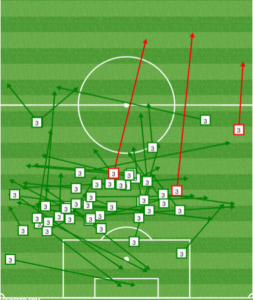
Drew Moor passing vs NE
It’s worth noting that these two clips show Hagglund and Williams playing the ball forward. That’s because, if at all possible, Drew Moor will simply move the ball side to side.
Moor, importantly, plays simple but fast soccer. The best secondary option for TFC when Bradley is tightly marked is to quickly switch fields and play the ball up the line. The outside center backs will stretch all the way to the touchline and encourage a midfielder to step forward to the ball. This forces the opposition fullback to mark TFC’s wingback and leave space behind. Remember Giovinco? Watch how this plays out below. Hagglund plays the ball up the line, it quickly goes past the fullback to a space where Giovinco can either create havoc by running at a central defender or draw a foul. He does the latter. Also, check out Vanney on the sideline; his players know exactly what he wants in this situation.
[gfycat data_id=DisfiguredWaryEeve data_autoplay=false data_controls=false data_title=true]
Here’s the thing, though. Both playing through Bradley and playing up the line haven’t been consistent chance-creators for TFC. Yes, they can get Toronto into the offensive third, and when things play out well, TFC can again use their shape to create superior numbers around the ball.
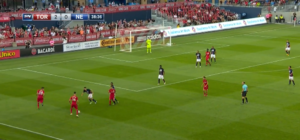
TFC can create attacking overloads, but their movement from these positions is questionable. Except Giovinco, that is.
But relying on young players who are good at a lot of things but not great in any one area has drawbacks. Namely, TFC’s young guys aren’t consistent in tight spaces. Endoh, Osorio, and Delgado all have their moments, but attacking coordination still lags far behind defensive coordination. As a result, Toronto is extremely reliant on Giovinco for offense.
In fact, Toronto would look a lot more like Colorado (great D, struggles to consistently score) if not for the Italian wonderbug. Just look at this shot. It’s not only crazy, but it might not even be that much more impressive than his first goal of the game, a first-time laser from a bad angle across the face of goal on a spinning loose ball.
[gfycat data_id=AdventurousLegalBlackfish data_autoplay=false data_controls=false data_title=true]
(It’s worth noting that there is definitely a foul on Rowe in the buildup to that goal. As much as I wish I could dismiss it as Rowe being a baby (he often is), you can’t just put your studs into a tackle like that. Luckily for Toronto, Ted Unkel’s primary goal as a referee is to convince everyone that he’s actually Leslie Nielsen’s character from the Naked Gun movies in disguise.)
Union goals
Philly’s goals defensively is fairly straightforward. First, keep Giovinco off the ball, or at least facing his own goal (same with Bradley). Second, pick up Jozy Altidore in the box.
After that, it’s all about keeping shape and communicating so Bradley is covered during buildups but organization remains throughout the rest of the defense.
Going forward, the Union need to move the ball quickly so they can attack the zones behind TFC’s wingbacks. Below, you can see New England with a chance to move forward, but Kelyn Rowe makes an angled run inside. This is easy for Toronto to cover because they have an extra central defender. The problems arise if Rowe pulls wider then immediately attacks, because now he’s facing up against a central defender and Drew Moor has to decide how far he should go to protect the area behind Hagglund.
[gfycat data_id=ZealousCreativeBarasingha data_autoplay=false data_controls=false data_title=true]
If the Union can get players isolated on central defenders, they have Tranquillo Barnetta and Alejandro Bedoya to make late runs into gaps in the box. Plus, they have Chris Pontius available in the air.
Below, you can see once more that Rowe is able to make a central defender man-mark him, but when he pulls Hagglund forward, nobody makes the run into the exposed wide area.
[gfycat data_id=UnlinedPlainFlicker data_autoplay=false data_controls=false data_title=true]
You can also see a very smooth TFC defensive transition after New England’s turnover. Even if Toronto’s young guys aren’t fantastic in tight spaces, they are very good in the open field, and quickly move from defense to attack when a team doesn’t cover the center well (looking at you, Koffie).
Prediction: Union 2-2 TFC
Philly has a good offense, so yeah, let’s see if they can drop a pair on a strong defense. As good as Toronto has been in back this year, they haven’t won on the road since April so the Union should have a good chance to go at a team that is hesitant to commit bodies forward away from home.
Philly has also been very good this season at attacking off turnovers in the opposition half when Barnetta plays in an advanced position. With Bedoya in support, they could be even better.
Bedoya is the Union’s ace in the hole for the playoff push, but Toronto has one of their own that I have barely discussed. Jozy Altidore has three goals and an assist since returning from injury, and if he wasn’t rusty he’d probably have had another (or two more) against Houston last week (check out Matt Doyle’s deep dive into Jozy’s work since returning from injury in the link above). Philly can match up pretty well against Altidore with Richie Marquez, but the Union’s defense has had trouble tracking key players on set pieces and on cutbacks all season. It will be interesting to watch whether Bedoya or Altidore can do more to tip the scales in their team’s favor.
The Union lineup is likely to look very similar to the team that razed New England last weekend. Ken Tribbett has been a CJ Sapong passed the first part of the league’s concussion protocol and is expected to play. Given that the Union are likely to have Bedoya and Warren Creavalle in deeper roles, then it will be interesting to see how they handle Giovinco. Creavalle could man-mark the striker when he drops deep since the Union No. 6 doesn’t thrive at shadowing passing lanes.
Final notes
Ben Baer’s look at full season expected points for each team puts the Union at fifth in the east at the end of the regular season, but almost nine points ahead of DC United. Philly looks set to battle it out with NJRB and Montreal for the 3-5 spots and a shot at home field advantage in the Eastern Conference knockout rounds. A home win against what will probably be the team to beat in the postseason would be a huge step in the right direction.
Finally, a look at American Soccer Analysis’ Expected Goals model shows that the Union have allowed almost seven more goals than the model would predict. Only New England, which has all the confidence of a vegetarian chef at a Texas barbecue cook-off, has a bigger difference between expected and actual goals allowed. So… mark that down in the “things should improve” category?


This is a great test game for the team. Can’t wait for Saturday.
I’m actually viewing it as a great test for Curtin this weekend too. The last time we played a team this defensively talented, we played Colorado with a freaking double pivot of Creavalle and Carroll since I believe Nogs was injured. The result was predictable: Not much offense to speak of on either side until the altitude/road weariness got to the Union, then the Rapids got moving and scored. Thankfully, BC (of all people) came to the rescue in stoppage time. This time through, Jim has the players available to put pressure on a good defense and I want to see what he comes up with.
To be fair, that game against Colorado was an away game. Also it was after playing the prior Wednesday against Orlando, again an away game.
Totally agree. The team had plenty working against them, and they still managed a result, to their credit. I was alluding to the fact that curtin didn’t have much choice of tactic, his hand was kinda forced. This game, he can try some things and dictate the game a little bit. Im curious to see how he does.
Ah, got it. I was reading your comment as criticizing Curtin for being so defensive that game when, really, the situation sort of called for it.
.
Now hearing where it is coming from, I couldn’t agree more. For this whole season actually too, not just this game. We have seen Curtin keep together a locker room in bad times but the question has always been his game management and tactics. Now with quality depth on the roster and in a playoff position it is interesting to see how he handles things as a young coach.
It’s gets a little repetitive to just write, “Adam, this is fantastic analysis” every week, but… I’m not sure what else to say at this point. Other than that I love PSP.
@scottso – Man, I do this because I love PSP too. I would never have had the personal motivation to vomit too many words about tactics 2-4 times a week if not for this site.
Adam, who should start at the right flank midfielder for the Union?
If I have correctly understood what you say the position requires against the TFC defense, it struck me that Isinho’s greatest strengths were not being emphasized in the requirements, as he instinctively sneaks towards the center and acquires wide pressure on the defense by feeding Rosenberry on the overlap rather than providing it himself.
@OSC – I actually think Ilsinho can do well on the flank with Barnetta central because Quillo moves so much like a winger and will look for those defensive holes in a way other #10s might not. So to the extent that Ilsinho can pull the wingback up, it could be good fit.
–
That said, you know my feelings on Herbers, and his nose for holes in the backline is one of his better qualities. I think Curtin will stick with Ilsinho, esp since Bloom is probably the best positional wingback TFC has and he’s out.
–
It’s an interesting question though, because over the past two months, Columbus has probably played the best game vs TFC, and that was with Toronto missing a lot of guys. But Columbus did what they do – stretched the defense out then attacked quickly up the wings. I don’t think Union will do that, but if that’s the template for success then Ilsinho probably not the best fit.
Ilsinho may be effective at pulling both the wingback and the wide CB out of position as TFC may choose to play tight to him knowing what he can do with the ball on his feet – both passing and dribbling. Hopefully it will open space for Rosenberry on the wing and allow Barnetta to play in the whole just behind and off-set from Bradley
Honestly, there’s no other articles or writers from who I learn more about the sport. Thank you Mr. Cann. Thank you.
@Jon – Thank you! By far the best part about writing for PSP is the hope that people read it and dig on soccer just a little bit more.
I’ll give you credit for last week calling for 3 when this team’s road play has been abysmal. Kudos. I was wrong.
I did my own run thru of the schedule and agree, even if we drop this game, we look like we will battle MTL for 4th/5th. Also agree TFC is legit,and I think Tribbett will be like a Chicago voter…tested early and often.
@scottymac – I only got it right in guessing that the U would score a few. I definitely didn’t think NE would continue to do a Sad Brady all over a once-promising season; I thought they’d push back!
It’s worth noting that in the article Ben Baer wrote, his projections are based on the team’s whole season performance up to this point. In other words, it does not account for things like, let’s say, a major deadline signing who has had little time to impact thus far. This is most pertinent to the Union and the Sounders, who shouldn’t, in my opinion, read too much into those projections.
.
That being said, the next 5 games are critical. 3 at home, 2 on the road against bad teams (Chicago and Columbus). The goal has to be over 10 points, since after that it gets rough.
The thing about the Bedoya signing, he gets us back to Nogs level PPG, maybe a touch higher. I wouldn’t expect much more for that role. But that PPG pace was as a playoff team and maybe a round or two deep. Ale stops the hemorrhaging, but doesn’t necessarily make us much more of a contender than we were. Yes, Edu may come back and Charlie Davies may get fit and contribute, those two may make the difference. I just don’t trust Edu sliding into the role and meshing well.
I’m not sure it even gets super tough after that.
.
@Portland – Tough, but they have a CCL match that Tuesday.
.
@Toronto – Loss
.
@NYRB – Tough, but we seem to have their number this year. A point or three here is very doable.
.
Orlando – 3 points
.
NYRB – See above
I see your point on those games for sure, I just mean that these next 5 should be comparatively easier. I think we could win 4 of those games, but they’re less assured than these first 5.
“Interesting” to see how the Warren and Bedoya handle General Bradley & Atom Ant.
I have other words for it……..
I wouldn’t actually be opposed to Creavalle shadowing Giovinco. Bedoya and Barnetta have the positional discipline to control the center of the park. Shutting down Giovinco is priority number one.
I think Gio could draw two yellows from WC in about 30 minutes.
Creavalle can’t shut down Gio on his own. I expect if they tried that this game would easily go Toronto’s way as Creavalle can’t keep up with Gio and his skills.
I wish we had Carroll for this one. His passing has been so huge in the games against high pressure teams this year (never thought I’d see the day I’d be praising Carroll as a passer).
Adam, you mentioned Bradley’s ability in tight spaces to be one of his strengths. Do you feel like that’s the case in MLS and internationally? I know Bradley gets a lot of flack for his play under pressure by many USMNT fans.
.
Personally, I think much of that is due to the lack of options he’s been given in the middle of the field in big matches. It seems like Jurgen tends to overestimate his abilities and leave him alone in the middle without a creative attacking outlet.
@Kev – In a recent interview, Greg Vanney said that one of the reasons he plays Bradley deep is that dude likes to receive the ball facing forward. I’d add to that that he’s very good when he receives the ball on the half-turn as well. But I think he’s not nearly as good at handling pressure when he’s facing backwards. This might seem obvious, but some players are fairly confident facing away from goal. Ilsinho, for an easy example, doesn’t seem to mind that he needs to create his own space when he receives the ball.
–
But I think playing further forward, Bradley gets the ball facing away and has to take a touch or two before he can pick his head up and look around. When he’s deep enough to get the ball facing forward, he already knows where he’s going with it bc his awareness is pretty fantastic. So even if he’s being closed down quickly, he can first-touch longer passes or more nuanced passes better than almost any other deep-lying mid in MLS.
–
I’m not sure that explains everything, but I think it’s part of the story. I also think that Bradley is a guy who figures out the system he’s in and develops very good intuitions about where he should be and where the ball should go. The US tends to change shapes and tactics surprisingly often, and I think this slows Bradley down in his decision-making. So a few things at play there.
–
And I think that last point is pretty much the same as what you’re saying. I’d modify it a little to say it’s not always lack of options, but sometimes just not having an intimate knowledge of what his options are and how to prioritize them.
I could not agree more with your impression of the midfield use of Bradley, and think that the Union is actually playing a back line that allows for that to be exploited. Too many times this year, I have watched the long cross that either Rosenberry or even Fabinho launch drop to the feet of an opposing defender. If TFC does spread the back line like they appear to be doing in your clips, and if Bradley does step to fill a high pressure location, then a counter from the weak side, along with both Bedoya and the wings pushing forward will be helpful. Even the central backs can watch for that and launch the seeking ball.For years, I have criticized the EPL long ball style that the Union defenders loved so much, but here it seems to actually either balance out the TFC high line, or exploit the extra-man defensive numbers. Here’s hoping. Thanks, Adam
Well done, Adam. I’m excited to be going to the match tomorrow so I can watch the whole pitch to track how these specific tactical battles play out. Thanks.